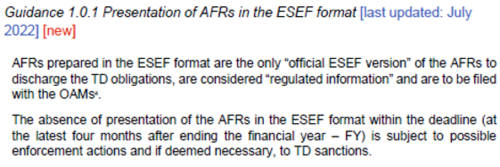Changes in the ESEF Reporting Manual 2022 and Its Consequences
The ESEF Reporting Manual, published by ESMA, has been released in its 2022 iteration and comes with a lot of important changes. This year ESMA has worked closely with the community and made some much-requested improvements and clarifications to the manual.
The big topic of the upcoming reporting period is of course textblock-tagging. New sections in the manual clarify the scope and intent, as well as the technical challenges involved in this requirement.
In this short article we want to inform you about the changes and what consequences those have for you.
There is only one ESEF
In some jurisdictions ESEF was not considered the actual “Annual Financial Report”. With this new section in the reporting manual ESMA clarifies that indeed, the ESEF report (and not the PDF or any other derivative of the document) is the only official Annual Financial Report. As such, this report should also be published on the website of your company (Ideally also with a viewer to make it more readable). It is also possible to publish additional documents (e.g. a PDF), but those do not serve the function as official Annual Financial Report.
When does this new manual come into force?
Independent from the used taxonomy version, this manual SHOULD be taken into use as soon as possible but not later than for reporting periods starting after January 1st 2022. When in doubt you should check with your local OAM.
Reports in more than one language (Guidance 1.1.2)
In practice there is no change to reports in the past, but this is a clarification from ESMA:
While you can have labels in multiple languages in the extension taxonomy, the report language itself will only ever be in one language. If you want to file in more than one language, you have to reapply all tags to a version of the report in that or those language(s).
Tagging of disclosures that do not apply (Guidance 1.3.3)
ESMA clarifies that it is NOT necessary to include sections with content like “not applicable” in your report only to satisfy the requirement of tagging a specific element from the annex. If you don’t have a section matching a required tag, you can omit said tag from the report.
This is the “technical” viewpoint. You should, however, check if your report should maybe contain information for said tag.
Text block tagging (Guidance 1.9)
We are covering this extensively in a whitepaper that will be released soon. Stay tuned!
Granularity of block tagging (Guidance 1.9.2)
In the past there was confusion whether to tag single cells, rows or columns with text block tags if they correspond to an element. ESMA clarifies for text blocks, that the lowest level of granularity to consider is the entire table. It is not required to apply elements to single cells, rows or columns and instead should be applied to the entire table.
Facts duplication (Guidance 2.2.4)
In prior versions duplicate tags where only mentioned for numeric tags, not for text tags. Now ESMA has clarified that also non-numeric facts that have different content for the same period are considered duplicates. If you want to tag multiple parts of the document with the same tag, you have to use the continuation mechanism of XBRL and such define a sequence of content for the same tag.
Tagging of dashes and empty fields (Guidance 2.2.5)
In the past there was a bit of confusion as to how fields that contain a dash “-“ or no value should be tagged in tables. ESMA clarifies that, while there is still no requirement to tag this information, it is now recommended to tag dashes or empty cells accordingly.
If you decide to tag this information you have to be clear about the meaning of the dash.
Does it represent a 0? Then you have to apply the fixed-zero transformation.
Does it represent “nil” or “not available”? Make sure you set the AsNil property to true.
Technical limitations of text block tagging (Guidance 2.2.6)
XHTML documents derived from PDF documents follow a fixed document structure, while XHTML documents derived from Word document have a semantic structure. This basically means, that while Word-based XHTML documents define structures like table, row, cell or paragraph properly in the source code, PDF-based XHTML documents only position the content in a way that it “looks” like for example tables.
ESMA is of the opinion that ESEF reports in the future should follow what they call “meaningful” XHTML, e.g. documents with a semantic structure. They acknowledge though, that the demand for “glossy” layout is very high and Word-based or other documents do not achieve the same level of sophistication regarding layout as PDF-based documents.
The XBRL community will take a closer look at this problem in the next years and try to tackle this problem. For now, PDF-based documents are still within the rules of the manual and no specific date for a mandated change is given.
Standard labels in extension taxonomies (Guidance 3.4.5)
In some jurisdictions it is a requirement by the auditors that the labels in the machine-readable part of the report resemble exactly the description in the human-readable layer. This is not a requirement from the reporting manual.
In the past this was achieved by adding new labels in the extension taxonomy that also have the label role “Standard” but a higher priority than the label in the IFRS/ESEF taxonomy. With the new reporting manual ESMA clarifies that this is no longer allowed:
Issuers will now HAVE TO use e.g. the verbose label role if they want the match the labels from the human-readable report with the labels in the machine-readable report.
Siehe auch
![]() Further Guidance
Further Guidance
![]() Changes to the ESEF Reporting Manual 2023 and Its Consequences
Changes to the ESEF Reporting Manual 2023 and Its Consequences
Weitere Inhalte
→ Webseite
→ Kundenbereich
→ YouTube



